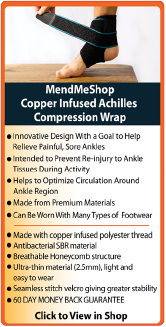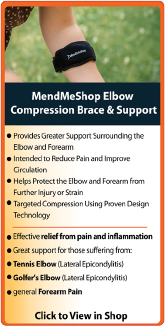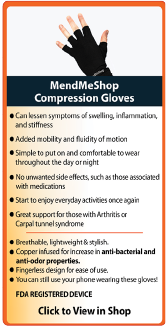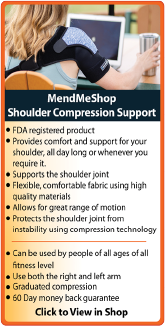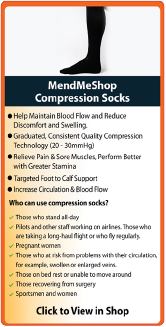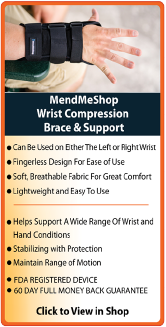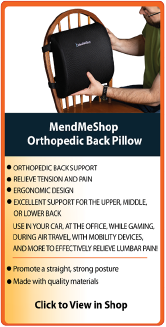|
|
What is Popliteus Tendinitis?The popliteus is a small muscle that runs behind the knee and the popliteus tendon connects the popliteus muscle to the thigh bone (femur) at the upper inside rear of the knee. The other end of the popliteus connects to the outside (lateral) front of the lower leg at the tibia. Compared to the hamstrings above, and the calf below, it is often overlooked in knee and lower leg injuries. The popliteus is an important contributor to overall knee stability and proper knee flexion. The hamstrings refer to 3 long posterior leg muscles, the biceps femoris, semitendinosus, and semimembranosus. These muscles start at the bottom of your pelvis extending down the back of your thigh and along either side of your knee, to your lower leg bones. The popliteus has four basic jobs1. It helps us to start the motion of flexing the knee/leg. 2. Once the knee is straightened, the popliteus muscle allows the knee joint to unlock and return to motion. If you have tightness or shortening of the popliteus you will not have full range of motion with your knee joint (less bend with the knee and an inability to fully straighten your leg). 3. The most important movement that the popliteus helps with is the hinge action of the knee between the upper and lower leg. For a runner, this becomes critical as a balanced gait is only achieved when this muscle is functioning properly. While running (when there is substantial speed and power when your feet make contact with the ground), a healthy popliteus muscle is very important; shortness of the popliteus during a run would lead to an improper foot plant and excess pronation. 4. Finally, the popliteus withdraws the meniscus in the knee to prevent the tissue from becoming trapped (impinged) in the knee joint. Symptoms of Popliteus Tendinitis?Popliteus Tendinitis causes pain at the back of the knee in the fold of your leg, that ranges from mild to severe. Walking downhill or extensive running will increase pain. Standing on a slightly bent knee or rotating the knee may increase your pain. Some people may experience a cracking sound from the tendon when moved or touched. You may feel that your injured knee may give way under stress or may lock or catch. Chronic popliteus tendinitis will manifest as pain - first thing in the morning. For runners with a popliteus strain/tendonitis - they will experience pain at the start of a run although this pain will slowly subside as the run progresses. Why? As you run, your heart rate increases, as does the blood flow to the popliteus - the effect of this increased blood flow is a reduction of swelling & inflammation in the popliteus during the run. What Causes Popliteus Tendinitis/Strain ?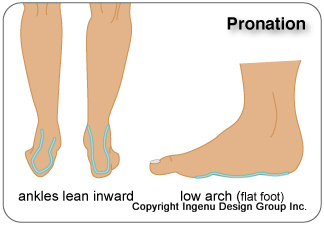
If you suffer from knee instability, we recommend our MendMeShop Knee Support & Compression Sleeve. If you are experiencing pain due to soft tissue strain or inflammation, we recommend our Arnica Pain Cream. These 2 products are inexpensive - if pain and tightness is becoming a problem, you will be surprised how much easier your day to day life will improve just from these 2 items. Grades of Strain:
How do I Diagnose Popliteus Tendinitis?A visit to your doctor is the best way for diagnoses of any type of knee / leg pain. To help your doctor discover your diagnosis, he/she will begin with a medical history about you, your current condition and symptoms. He/she will ask about the level of your pain, how long you have had your symptoms and the limitations you are experiencing. Details about what and when problem started, and whether or not you have ever had treatments for this or a similar condition in the past, are very helpful in assessing your injury. The symptoms of a popliteus injury are very similar to those of an MCL (Medial Collateral Ligament) tear or meniscus tear. Your doctor will likely ask you to perform a 'muscle test' to cause the muscle to contract; they will be looking for weakness and pain in the popliteus area. Diagnostic testing may be ordered to help discover the source of your leg pain - this is often used to rule out other conditions. MRIs (magnetic resonance imaging) will provide more detailed information and will help evaluate the soft tissue in and around the knee (muscles, tendons, ligaments, and other connective tissues). Not only can an MRI identify ligament or tendon damage, it can help to determine the extent of your injury, the displacement and degree of your tear or inflammation, as well as other associated knee / leg conditions. How Do I Heal My Popliteus Tendinitis - What Can I Do?The good news is that most cases of popliteus tendinitis will heal with simple home conservative treatments within 6 weeks. Prolonged healing time combined with re-occurring symptoms is an sign that you have a chronic condition. If symptoms persist for greater than 6 months of conservative treatments, then surgery may be needed. It is generally understood by doctors and surgeons, that surgery will introduce more scar tissue into the soft tissue of the tendon. This added scar tissue will be problematic, requiring visits to the clinic and conservative treatment options post-surgery. This is why surgery is only performed as a last resort for chronic tendinitis injuries that won't heal with conservative treatment methods. Some conservative treatment methods recommended include:
If you need to have surgery, talk to your doctor about using these same products for post-surgery recovery. You'll find them effective for reducing post-surgery inflammation, enhancing range of motion and minimizing the growth of scar tissue in your popliteus tendon. No one is immune to tendinitis, you can easily reduce your risk of further injury with consistent conservative treatments Step 1 - Reduce Pain & Swelling with Cold CompressionThe 1st step for conservative treatment of your popliteus tendinitis is to reduce the swelling to "open up" the area for more blood flow. Anyone in the health-care business knows that your blood supplies the oxygen and much needed nutrients required to heal any soft tissue injuries. This is why for years doctors, trainers and other medical professional have recommended RICE (Rest, Ice, Compression, Elevation) to treat the pain and swelling of fresh injuries, chronic pain, and after any re-injury. Cold Compression Slows nerve and tissue function - reducing the swelling that blocks blood vessels from doing their job. Use a Cold Compress or Ice Pack:
Step 2 - Improve Circulation, Soften Scar Tissue & Prevent Re-Injury with Circulation BoostAfter the inflammation in your tendon has been reduced, providing extra blood flow and strengthening the tissue around your knee is recommended.
Use Circulatory Boost TShellz Wraps®:
 Continue the healing process by resting your leg. Limit the activities that may be aggravate your tendons. Without proper rest and limitation on activities, being active as if your leg is healthy can lead to re-injury. We spend hours on our leg through simple daily routine, recreational activities, exercise, or participating in athletics. To get back to doing the things you love you need to give your body proper care and attention. Why risk having to limit or give up your favorite weekend activity, your exercise routine, or even your job due to an injury? Step 3 - Strengthening, Stretching, and Scar Tissue ReductionAfter you have started the healing process of your damaged popliteus tendon. The final step to over all recovery in the cycle is improving the tendon strength. If you are well on your way to recovery in a short time, do not let the size of the tendon fool you. The small size may help you recover quickly but it can be re-injured easily and severe enough to stop you from pain! Exercises should consist of non-weight bearing and weight bearing exercises. 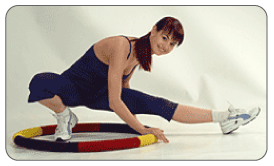 Stretching non-weight exercises are important to less painful movement and activity, increase blood flow and help you deal with scar tissue. An effective stretch should be held for at least 30 seconds. A stretch should never be painful. You should only feel a gentle lengthening or release in the stretched tissue. Your doctor or health-care profession will provide you with a list of correct exercises for your pain level. They often include; wall squats, hamstring stretches, quadricep stretches, hip flexor stretches. Strengthening weight exercises are important to create stability of the knee joint, correct muscle imbalances and build muscle endurance. Your doctor or health-care profession will provide you with a list of correct exercises for your pain level. They often include resistance band leg curls, resistance band reverse heel tap, ball squats, and/or step task. If you have been suffering from chronic popliteus tendinitis you have likely travelled down the re-injury path with your knee by not giving yourself enough time to completely heal your injury. Lack of stretching (to keep your knee tissue elastic and strong) will typically lead to an unneccessary build up of inelastic scar tissue in the muscle/tendon - this increases risk of further strain/tearing. Conservative Treatment Tools to Help Deal with Scar TissueIt's important to give adequate time to rest tendon tears - the body's natural healing process takes time to heal completely. If you don't rest your torn tendon, your acute tendinitis can quickly turn into a chronic tendinitis injury. To repair damaged tendon tissue quickly, the body will use scar tissue to fill in soft tissue tears. If you need to rest for an extended period of time and avoid activities that you did before your injury, you'll be more likely to develop substantial scar tissue as a temporary healing measure. The key is to try and minimize the scar tissue growth while you heal. Scar tissue may plague you for weeks, months and maybe even years, depending on your level of activity and the amount of conservative treatments you have done during your rehabilitation. Scar tissue is a major problem, especially when it comes to re-injury of your tendon. When dealing with scar tissue it's always important to:
In our opinion, the Knee TShellz Wrap® will assist you in recovering from your injury faster and reduce your risk of chronic (long term) injury. Product Advisors are available 9:00 am to 5:00 pm Eastern Standard Time Monday to Friday. Learn More About Tendon Injuries & TreatmentsI want to learn more about Post-Surgery Recovery I want to learn more about TShellz Wrap® Circulatory Boost I want to learn more about Ice & Heat: Which Is Better For Treatment? I want to learn more about Tendonitis Treatments I want to learn more about Tendonitis Surgery FREE SHIPPING ON ALL PRODUCTS CURRENTLY ENABLED |
 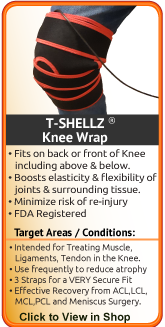     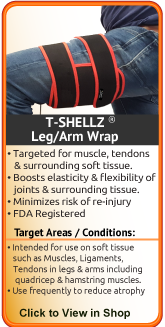 |

